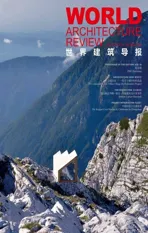New Courthouses System
2019-05-07
设计工艺过程的系统化带来施工过程的系统化
这些法院大楼的设计被视为一个契机,用以强化厄瓜多尔公共建筑整体施工过程需要优化的需求,所采用的规划模型一方面基于模块化建筑组件、生产工序标准化、轻型预制和干式装配方法,另一方面基于设计方法的系统化,从而可制作出具备充分灵活性的通用模型,可根据具体环境和不同情况需求进行调整和适应。
因此,按照工作需要给出的详细功能相关性,对这20个项目进行了系统化,根据用途(无论是公共、半公共或私人用途)逻辑生成了项目模块,通过用以施工优化的结构-空间建筑模块在尺寸上做出决策。这些项目模块的功能动力也是基于法院大楼运行要求确定的双重流通体系及空间垂直分布逻辑,将上层空间集中服务私人用途的同时,让底层优先满足公共用途。
这样,就可为项目子系统生成一系列模型,根据最坏项目情景,对20个项目进行同时评估和决策,即为一个项目进行决策,然后应用到其他十九个项目上。
总体布局和公共空间
场地上建筑物的布局对应着一个基本原则:公共建筑=公共空间
建筑物的总体布局与其环境相应,总会形成树木遮蔽的公共空间,包括广场、小广场、人行道加宽、和/或公园和绿色微公园。因此,建筑物中会融合开放式的门厅,作为公共内部和公共外部之间的过渡地带。此类门厅也是建筑元素,若在城镇中心规划新区,它们可让建筑物成为城市“场所营造”模型。
结构-空间格网
该结构系统本质上是一个钢筋网格,包括一个6.30米的正方模型,作为该建筑物的维度基础。为在施工过程中实现双重目标,即材料的最高效应用和时间的有效安排,特意探寻出一个具有合理性、重复性和不变性的结构系统。与其他更常见的、基于膜片或平板的结构原理相比,线性网格可在建筑物分布、空间组织、转换或扩展方面提供最灵活的解决方案。
轴间的6.30米模块与形成该网格的两个基本组件的尺寸相对应:6.00米长的IPN梁和0.30x0.30米的方柱;网格的这一模块规格实现了材料浪费的最小化,并优化了标准钢构件的切割。
分布和流通系统
其流通方案与法院大楼工作系统提出的特别需求相适应,所有开放的公共区域位于前部及较低楼层和底层,具有门厅和双层或三层高大厅。这些公共区域的分布,占据了底层和第一和/或第二层前部空间的大部分区域,面向外部的公共空间。为实现公共区域间的垂直流通,在建筑物中央设置了开放式楼梯和电梯;私人垂直流通涵盖在一个或多个可通向建筑物各层的核心块中,并与开放式的公共流通保持分离。
规模、物质化和适应性
审判室是建筑物中的主要空间场所,是举行听证会、伸张正义的地方,在内部公共空间上,位于第一层或第二层的主要区域,可通过体积大小清楚识别,并用天然木材装饰。空间方案与开放式平面原则相应,通过模块化石棉水泥板组成的轻型预制结构系统构成空间轮廓,石棉水泥板用于内墙、地面、天花板和外墙。该系统可让建筑物具有全面的灵活性,因此可通过调整适应新的项目条件、修改、扩展、翻新及零部件和材料在拆卸和回收方面的可能性要求。模块化预制干地装配系统也可在相对较孤立的地方,实现建筑物的有效施工。
建筑物主要通过其门厅与其周围环境相关,门厅是一个主要的防护和适应系统,而公众性越低的外墙,实际上,其开放度也是越低的。必要时,门厅和其他外墙可融入次级系统,在尽量不减少自然光照的前提下,保护建筑物免受太阳直射和雨水的影响。在这点上,每个地区或项目采用具体特定的材料,例如穿孔镀锌钢板网。
SYSTEMATIZATION OF THE DESIGN PROCESS LEADING TO THE SYSTEMATIZATION OF THE CONSTRUCTION PROCESS
The design of these Courthouses is seen as an opportunity to emphasise the need to optimize all constructions processes for public buildings in Ecuador,by implementing a planning model based, on one hand on modular building components, standardization of production processes, light prefabrication and dry assembly methods, and on the other, on the systematisation of the design methodology, in order to produce a generic model flexible enough to be modified and adapted depending on the specific contexts and needs of each case.
The 20 programs are thus systematized according to the strict functional correlations given by the operational needs, generating programmatic modules following logic of use, be it public, semi-public, or private use, and determined dimensionally by the structural-spatial building module selected to optimize construction. The functional dynamics of these programmatic modules are also based on the double circulation system determined by the operating requirements of the courthouses, and on the vertical distribution logic of the spaces, prioritizing public use on the ground floor while concentrating private use on the upper floors.
This way a series of matrices for the subsystems of the project are generated,allowing for simultaneous evaluation and decision making for the 20 cases at once,based on worst case scenarios, that is, always making decisions for one project and applying them to the other nineteen.
GENERAL LAYOUT AND PUBLIC SPACE
The layout of the buildings on the site responds to one basic principle: Public building = Public space
The buildings´ general layout respond to their context, always generating public spaces shaded by trees in the form of plazas, small squares, broadening of sidewalks, and/or gardens and green parklets. For this purpose, the buildings incorporate open portals that act as transitional space between the public interior and public exterior. These portals are also the architectural elements that allow the buildings to become an urban ¨place making¨ model in the case of areas intended as new centralities for their towns.
STRUCTURAL - SPATIAL GRID
The structural system is in essence a steel grid, with a square, 6.30 metre module, that acts as the dimensional base for the building. A rational, repetitive and invariable structural system is intentionally sought with the double premise of achieving the most efficient use of materials, and a time effective execution during the construction process. In contrast to other more common structural principles based on diaphragms or slabs, the linear grid allows for the most flexible solutions for distribution, spatial organization, transformation, or expansion of the building.

The 6.30 metre module between axes corresponds to the dimensions of the two basic elements that form the grid: 6.00 metre long IPN beams and 0.30 x 0.30 metre square columns; this modular dimension of the grid minimizes material waste and optimizes sectioning of standard steel members.
DISTRIBUTION AND CIRCULATION SYSTEMS
The circulation scheme responds to the particular needs defined by the operational system of the courthouses, with all-access public areas located to the front and on the lower and ground floors, characterized by the portals and double or triple height halls. These public areas are distributed occupying most of the ground floor and the frontal spaces of the first and/or second floors, oriented to the public space outside.Vertical circulation in the public spaces is solved with an open staircase and elevator placed in the centre of the building; private vertical circulation is contained in one or more cores that access all levels of the building, but are always separated from the open public circulations.
SCALE, MATERIALITY AND ADAPTATION
The Courtrooms are the primary spaces in the buildings, the places where hearings are held to impart justice, spaces located in a predominant area of the first or second floors above the interior public space, clearly identifiable as volumes clad in natural wood.
The spatial scheme responds to an open plan principle, spaces are defined with a light prefabricated constructive system of modular fibrocement boards, used for interior walls, floors, ceilings and facades. This system allows for total flexibility of the buildings so they can adjust to new programmatic conditions, modifications,expansions, renovations, and the possibility of dismounting and recycling of parts and materials. Modular, prefab dry assembly systems also allow the efficient construction of these buildings in relatively isolated places.
The buildings relate to their context primarily through the portals, acting as a primary protection and adaptation system, while the less public facades are by nature less open. When necessary, both the portals and the other facades incorporate secondary systems that protect the buildings from the incidence of direct solar radiation and rain, whilst admitting as much natural light as possible. It is here that specific materials for each region or case are employed, such as perforated galvanized steel screens.
